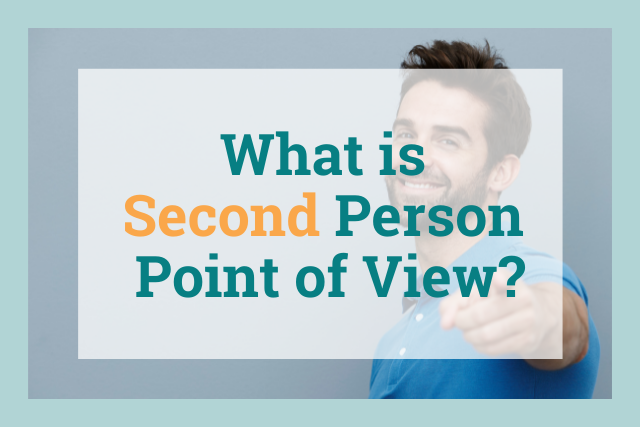
If you’re a fiction writer, you may have been told never to write in the second-person point of view. Or perhaps you’re a business writer who’s been told to always use it?
But what exactly is second-person narration and why do people have such fixed opinions about when it’s okay to use it?
This guide gives you everything you need to know, including helpful examples and practical exercises so you can get it right.
- What Is Narrative Point of View?
- First, Second, and Third-Person Point of View Example Sentences
- What Is Second-Person Point of View?
- Why Writers Use the Second Person
- Problems With Using Second-Person Point of View
- Should You Write Fiction in the Second Person?
- Famous Examples of Second-Person Point of View in Fiction
- How Do You Write in the Second-Person Point of View?
- Can you Switch POV When Writing?
- Second-Person Point of View Quiz
- In Summary
What Is Narrative Point of View?
Point of view is the narrative voice you use to write in. It tells us who is speaking and is split into first, second, and third person.
You might hear people talking in different terms to describe narrative point of view, including the acronym "POV", "narrative voice", and "perspective". They all mean the same thing.
You can usually tell the narrative voice easily by looking at the pronouns used:
- First person: I
- Second Person: You
- Third person: she, he (or a character’s name)
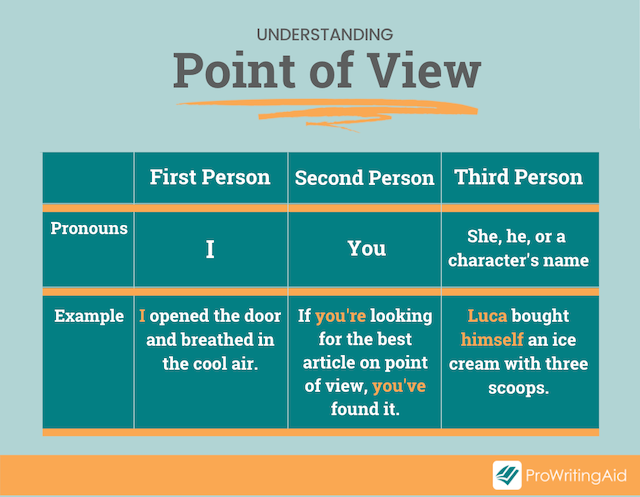
First Person Perspective
In the first person point of view, a character is telling their own story. It creates an intimate atmosphere, making the reader feel as if they know the character well already. First person can also intentionally restrict the information shared with a reader.
The narrator is limited to their own perspective on events and can only talk about the things they have experienced.
Second-Person Perspective
With second-person point of view, the writer addresses the reader using the pronoun "you". It forces the reader into the story, making them part of the action and complicit in events. This is hard to sustain over longer pieces of writing, which is one reason it is rarely used in narrative texts.
Third Person Perspective
In the third person point of view, the author is telling the story of different characters, but is not part of the action themselves. This perspective is further divided into "omniscient", "neutral", and "limited" perspectives.
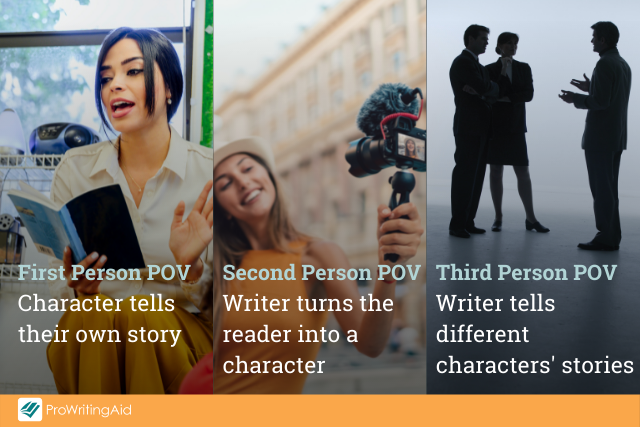
Looking for more guidance on using pronouns to construct point of view? Check out our guide to commonly confused pronouns to learn when common pronouns are used.
Why Is Second-Person Perspective Less Well-Known?
In school, you probably spent most of your time writing either in the first or third person point of view. These perspectives are well suited to writing stories, diaries, and recounts of events, the type of tasks teachers often use to improve writing skills.
Second-person narrative voice is used less often, and it comes more naturally in spoken language rather than writing. It can feel forgotten about, but that doesn’t mean you can’t use it.
First, Second, and Third-Person Point of View Example Sentences
Remember, looking at the pronouns of a sentence is an easy way to distinguish the narrative point of view being used.
First-Person POV Example Sentences:
- I didn’t know where I was going.
- Should I meet him?
- We went to the movies.
In the third example, you may have spotted the plural pronoun "we", which is also a sign that first person narration is being used.
Second-Person POV Example Sentences:
- You walk down the road, glancing behind you.
- You rub your feet at the end of the day.
- After finishing work, you decide to go for a drink.
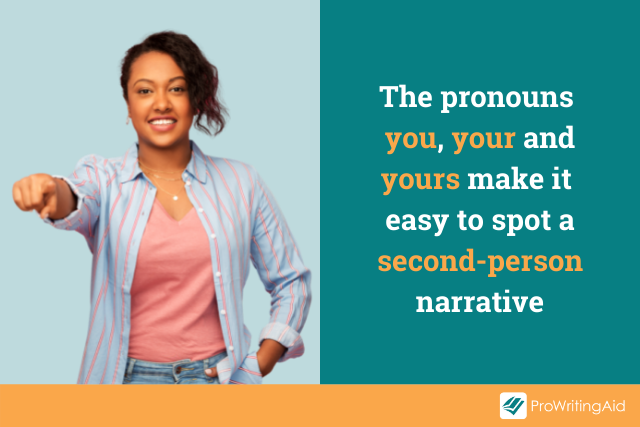
Third-Person POV Example Sentences:
- He was mean, but she tried to ignore it.
- They were the perfect couple.
- Tommy worked at the bank.
Characters’ names and the pronouns they and he/she help you spot a third-person narrative voice.
A Warning About Deciding POV
Avoid deciding which narrative perspective is being used based on a single sentence as this can be misleading.
For example, the sentence "they were the perfect couple" suggests a third person point of view. But what if we read it as a part of a longer extract?
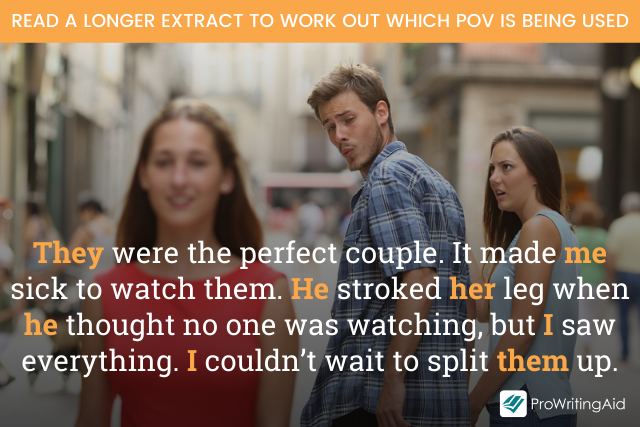
By reading a longer extract, we can see that this is written from a first person point of view. We can hear the character speaking to us about their feelings for the other characters.
To make sure you have correctly identified the narrative voice used, try to read at least a few other sentences to make sure.
What Is Second-Person Point of View?
Second-person perspective means addressing the reader directly. You’ll spot the pronouns you, your, and yours being used.
For example:
- Are you always running late for work?
- Your family means the world to you.
- You realise a moment too late that the purse is yours.
We often use a second-person perspective in sales and business writing because it can be persuasive. You’ll see it in slogans and adverts that are trying to make you take action, often using rhetorical questions for impact.
Copywriters use a second-person point of view to establish a bond and intimacy with the reader, to make them believe the writer really understands their situation.
This type of writing differs significantly from fiction writing because readers stay as themselves rather than imagining themselves as a character within a story.
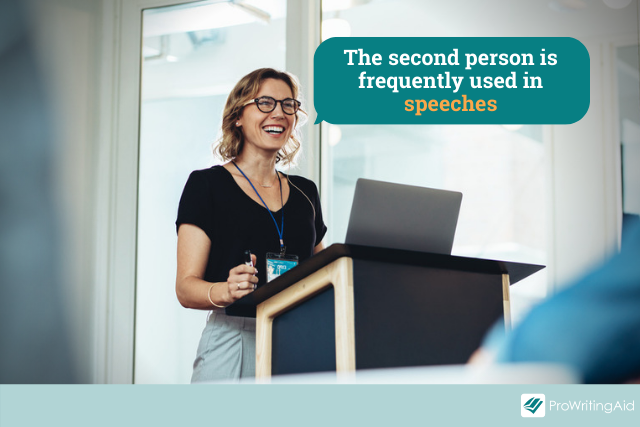
Speech writers often use the same approach. If they stick to a first person perspective, they can inadvertently seem too interested in themselves or removed from their audience. Second person shows they understand their audiences’ problems and want to help.
For example:
"You must be the change you wish to see in the world." - Mahatma Gandhi
You’ll also spot second-person perspective used in instructional writing, song lyrics, and video games.
These types of writing may seem very different from one another, but they all want to create an immersive feeling where you are at the center of the experience.
Why Writers Use the Second Person
Second-person narrative voice is intimate. It creates a conversation, immediately making you feel as if you know the person speaking. This inclusive experience can create feelings of trust, which are ideal for persuasive sales writing.
For example:
You work hard every day. When you get home, you want to relax, not work through a long list of chores. That’s why you need Daily Maids.
For fiction readers, a second-person narrative voice is an intense, immersive experience. They’re thrown into the action and become a part of the events that happen. As a writer, you can make them a friend or confidant, or even complicit in misdeeds.
Alternatively, the second-person narrative can create a sense of mistrust. The reader asks themselves, is the writer telling me everything? Can I trust what they’re saying?
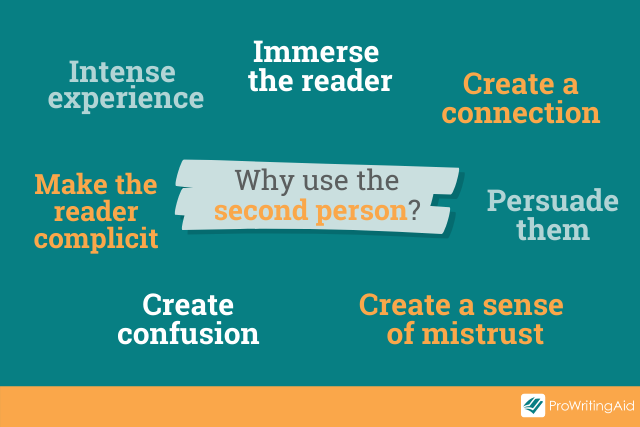
Problems With Using Second-Person Point of View
A second-person narrative voice can feel unrealistic if you don’t have a clear idea of your reader, although this can be useful if you’re trying to appeal to a specific type of customer. Second-person point of view can seem accusatory and suggest that you’re looking down on your reader.
This perspective is not often used in fiction writing because it is hard to maintain consistently over time. Readers enjoy feeling immersed in a story, but it’s hard for them to suspend their disbelief completely and become a part of the action.
Your reader may enjoy hearing about the life of a bank robber, astronaut, or knight, but can they actually imagine being them?
Should You Write Fiction in the Second Person?
You may have been told that fiction writing should only ever use the first and third point of view.
Many editors actively advise against using a second-person narrative voice at all. If you look at published works of fiction, you’ll notice how few of them ever use it.
Writing in second-person point of view can be:
- Distracting and jarring for the reader
- Repetitive and boring—only using the pronoun "you"
- Unrealistic
But does that mean you shouldn’t use it?
That’s for you to decide. While there are fewer examples in literature of second-person point of view, they do exist. Your story may only work if it’s told from this perspective.
Before using second-person perspective, ask yourself:
- Can my story be told from a different perspective?
- Why is second-person POV essential to my story?
- Can I sustain this narrative voice for the entire text?
- How will I prevent it from becoming unrealistic or repetitive to read?
Using a second-person perspective creates a unique and distinctive voice. It helps you stand out from the many other stories being told.
While it’s probably best not to pick it just to get you noticed, there is a place for second-person point of view in fiction writing. Just be aware that it could make it harder to get your writing published unless you’re seeking a self-published route.
You’ll see second-person point of view most often used in short stories, flash fiction, poetry, and writing for children.
It works particularly well for "choose your own adventure" type stories. Maybe your writing needs to use this perspective too?

Famous Examples of Second-Person Point of View in Fiction
The famous examples of second-person point of view are, in part, well-known because they are striking and unusual deviations from the "rules" of fiction writing.
These popular examples are well worth a read:
- Bread by Margaret Atwood (short story)
- Complicity by Iain Banks
- If on a Winter’s Night a Traveler by Italo Calvino
- The Reluctant Fundamentalist by Mohsin Hamid
- Bright Lights, Big City by Jay McInerney
- There’s a Dragon in Your Book by Tom Fletcher (children’s fiction)
- Half Asleep in Frog Pajamas by Tom Robbins
- The Diver’s Clothes Lie Empty by Vendela Vida
If you are considering using second-person point of view, it’s useful to read examples of published authors so you can uncover the techniques they use and make it work effectively for you.
How Do You Write in the Second-Person Point of View?
As with all writing, practice makes perfect. Try changing sentences written in the first and third person into the second-person point of view.
Don’t forget to explore tense too. Try writing in second-person perspective in the present and past tense and consider the effect it creates.
Reading published examples of second-person point of view writing will help you learn how to do it successfully yourself. Look for examples, especially in advertising, and unpick the effect they have on you as a reader.
Stay aware of narrative voice while you write, rather than your own voice. It’s very easy to slip out of perspective.
Keep in mind who is speaking. Add description so your reader can imagine themselves there to make it feel more believable.
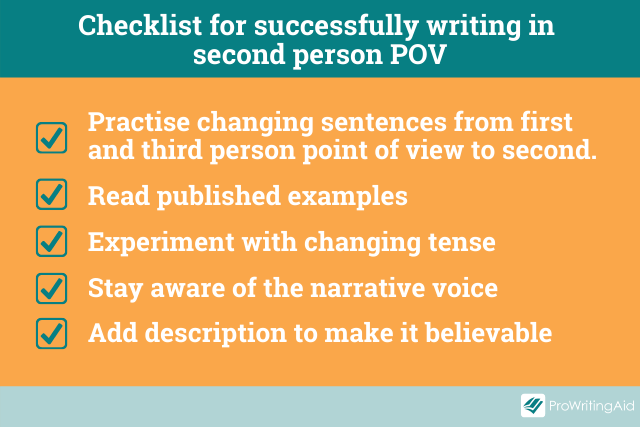
Can you Switch POV When Writing?
Generally, it’s best to keep to the same point of view throughout a piece of text. It can feel jarring for the reader if it changes, so when it’s used, it is for a deliberately unsettling effect.
For example, an opening to a murder mystery could be written in second person to make the reader feel part of the action during the murder, giving them tantalising clues (and red herrings) before switching to a traditional third-person narrative voice.
If you do want to deliberately change narrative voice, make it clear to the reader:
- Limit it to a prologue and/or epilogue
- Use deliberate changes of font and style
- Use chapter breaks and titles to signal the change
Copy and speech writers do get to regularly break the unwritten rule of maintaining the same narrative voice, but they do so in a deliberate (and limited) way. They often move between second person singular and inclusive first person plural.
For example: You want the best for your children. We all do. That’s why you’re investing in their future.
By shifting to an inclusive first person POV, they create a rapport with their reader and avoid sounding superior or aggressive.
Maintaining Second-Person Point of View
Writers often drop out of the second person without realizing. If you want to write in the second person, run your document through ProWritingAid’s Pronoun Report to check your point of view is consistent.
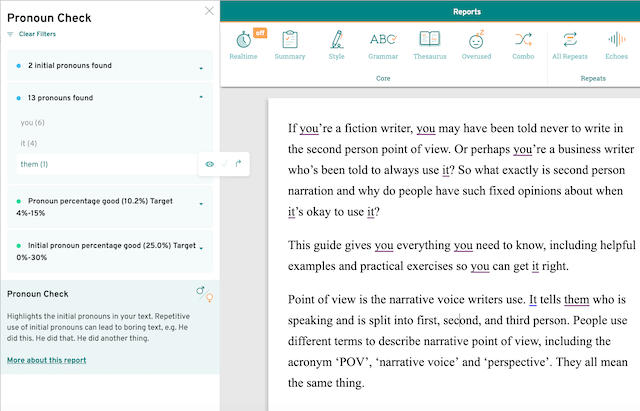
You'll spot any rogue first or third person pronouns quickly so you know which sections you may need to fix. In the example above, you can see I've used the third person "them" in the last paragraph. By scanning the list of pronouns to the left of my screen, I can jump to the potential POV problem areas quickly.
Second-Person Point of View Quiz
For each of these questions, can you correctly identify which one uses the second-person narrative voice?
Question 1:
A: She walked slowly towards him.
B: You walked slowly towards him.
C: I walked slowly towards him.
The correct answer is: B. The pronoun "you" shows this sentence is in the second-person POV.
Question 2:
A: It’s hard for me to speak about it.
B: It’s hard for Tommy to speak about it.
C: It’s hard for you to speak about it.
The correct answer is: C. The pronoun "you" is used in both past and present tense writing.
Question 3:
A: Dip the chicken pieces into the breadcrumbs.
B: I dip the chicken pieces into the breadcrumbs.
C: Tracy dips the chicken pieces into the breadcrumbs.
The correct answer is: A. Although the pronoun "you" is not used in this sentence, it is implied. This is often seen in instruction writing.
Question 4:
A: Do I have enough money saved?
B: Does Sarah have enough money saved?
C: Do you have enough money saved?
The correct answer is: C. Rhetorical questions are often used by copywriters and generally written in second-person POV because they’re designed to make the reader think.
Question 5:
A: She is an adorable puppy. You want to take her home.
B: She is an adorable puppy. I want to take her home.
C: She is an adorable puppy. They want to take her home.
The correct answer is: A. Although the pronoun "she" is used in the first sentence, the second one reveals the narrative point of view using the pronoun "you".

In Summary
It can be difficult writing in the second-person point of view and you should use it for a specific purpose rather than as a random choice. It’s very suited to some forms of writing such as copy, instructions, lyrics, and speeches. It’s far less commonly used in fiction writing, because it can feel unrealistic and is hard to maintain over a long period.
If you want to get published traditionally, writing in this narrative voice is generally not recommended unless your story can’t be written any other way.
Learning to write from a second-person perspective takes practice. Reading published examples and experimenting with switching the point of view of sentences will help you get used to using it.
Now is a wonderful time to be a copywriter. Download this free book to learn how:
This guide breaks down the three essential steps you must take if you think copywriting is the career for you.
This article contains an affiliate link for Masterclass.



